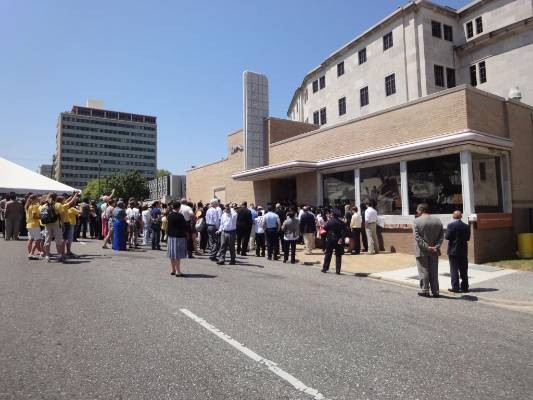Montgomery Greyhound Bus Station and the Freedom Riders Museum
Introduction
Text-to-speech Audio
Images
The station itself was constructed in 1950 and officially opened in 1951. The building is now a museum dedicated to the Freedom Riders.

Backstory and Context
Text-to-speech Audio
The Greyhound Bus Station is a small, single-story building constructed in between 1950 and 1951 in Montgomery, Alabama. The station contains elements of Modern style which includes horizontal emphasis, asymmetry, and windows that wrap around the corners. It underwent several alterations since the original construction. It is still recognized as a mid-20th-century bus station.
Throughout the 18th and 19th centuries, many states legally segregated facilities, schools, and public transportation for Black and white Americans. On May 20th, 1961, a group of integrated 21-year-old college students from Nashville arrived at the bus station. Calling themselves the Freedom Riders, they traveled to deeply segregated parts of the South on an interstate bus to bring an end to racial discrimination and segregation. When they disembarked in Montgomery, a mob attacked the Freedom Riders. Future United States Representative John Lewis, then the student leader of the Freedom Riders, shouted at the mob that attacked them. He said, “Stand together. Don’t run. Stand together!” Several of the students jumped over a wall and ran into a federal building next door. Lewis, William Barbee, and Jim Zwerg were trapped at the bus station and beaten unconscious. Zwerg was a white man who received most of the violent attacks. The Freedom Riders had seven female members. They managed to find a Black taxi owner who would take only the five Black female members. John Seigenthaler, a federal representative, attempted to rescue the other two stranded white women; however, the rioter knocked him unconscious with a metal pipe
The Freedom Riders’ non-violent acts of courage helped end racial segregation and change unjust laws. There is an award-winning exhibit on the building that traces the Freedom Riders’ history. It portrays the words and images from the Freedom Riders, those who supported them, and who opposed them. The interior exhibits provide additional information about the Riders, and the way buildings were designed during the racial segregation era.
The property is no longer used as a bus station and closed in 1995; however, it was saved from demolition and restored. In 1996, it was labeled as a historic landmark. In 2011, a museum was opened inside of the old bus station. It is listed on the National Register of Historic Places. In 2011, the museum won a national preservation award from the National Trust for Historic Preservation.
Sources
National Register of Historic Places Program: African American History Month Feature 2012 Montgomery Greyhound Bus Station, Alabama. https://www.nps.gov/nr/feature/afam/2012/Montgomery_Greyhound_Bus_Station.htm (accessed April 30, 2018).

